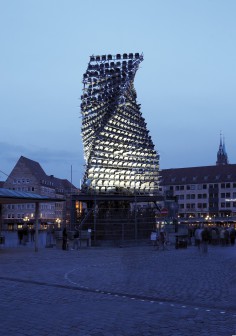Olaf Metzel

source: wentrupgallery
Olaf Metzel was born in 1952 in Berlin. From 1971-1977, he studied at Freie Universität Berlin and at Hochschule der Künste Berlin. After figurative work (Roter Beton, 1981), Metzel soon turned to spatial installations that right from the beginning were characterized by a special interest in socio-political questions (Türkenwohnung Abstand 12.000,- DM VB, 1982).
Olaf Metzel’s art appears to be aggressive, destructive, provocative. The works with the loaded titles are meant as explicit commentaries on political issues and their communication in the media, but also on a saturated art world that seems to already have conceived and seen everything.
Metzel sees art as a form of interference, as action, and thus also draws attention to its action-linked potential: In his probably best-known installation 13.4.1981, which was accompanied by harsh protests, as part of the Berlin Skulpturenboulevard 1987, Metzel refers to the demonstration on 12/13 April 1981 that took place in reaction to the false report of the death of the incarcerated RAF-prisoner Sigurd Debus. The artist assembled the red-and-white police barriers, positioned at the same place opposite Café Kranzler, into a tower-like sculptural body.
Metzel’s concern is the potential of sculpture in public space. He uses barriers or stadium chairs, objects that are usually present in an urban context that have symbolic value, places them in public spaces, and forces people to react – in the case of the Berlin installation mentioned above, the reaction was that the Berlin government had it removed. However, calling them critical commentaries of current events or manifestations of protest does not exhaust the interpretation of his works. Rather, behind the spirit of Metzel’s works, which often appears to be critical and destructive and which frequently involves a controlled destruction by the artist’s hand (Idealmodell PK, 1987; Laborprobe, 1990; Milieufragen, 2007), there is also an aesthetic dimension and an artistic self-interrogation: the subtle composition of frequently specially constructed objects, their formation, formats, and materiality in their site-specific context reveals both destructive and constructive aspects.
Olaf Metzel had his first solo show in 1982 in West Berlin, with numerous subsequent solo exhibitions both in Germany and abroad. In 1987, he was a participant in Documenta 8 in Kassel, and in 1987 and 1997 he was part of the exhibition »Skulptur.Projekte Münster.« In 2006, he acted as the curator of the exhibition »YBA – Young Bavarian Art« at Gagosian Gallery, Berlin, a project that was part of the Berlin Biennale and initiated by Maurizio Cattelan, Massimio Gioni and Ali Subotnick.
Works of Olaf Metzel are amongst others part of the collections of Bayrische Staatsgemäldesammlung,Munich, Kunstsammlung Nordrhein-Westfalen, Düsseldorf, Staatsgalerie Stuttgart, Museum Ludwig, Cologne, HamburgerKunsthalle, Collection Deutsche Bank, Sammlung Falckenberg, Sammlung Ackermans.
.
.
.
.
.
.
.
source: newsartnet
Olaf Metzel was awarded one of Germany’s most highly remunerated art prizes on Friday for his 2011 artwork Noch Fragen. The €50,000 ($69,100) mfi Prize is given every two years in recognition of the Germany’s best new piece of public art. Metzel’s installation hangs from the ceiling of the new reading room in the State Library in Berlin and consists of aluminum plates printed to look as if they are crumpled up Post-it notes, newspapers, and book pages.
The work was practically ready made for the prize, which, according to its founder Reydan Weiss, looks for a direct connection between the work and the context in which it is installed rather than for artistic innovation. The work was selected from 63 submissions by a jury of six art experts, artists, and journalists.
Born in Berlin, Metzel has been a professor at the Munich Academy of Fine Arts since 1990. He’s represented by Wentrup gallery in Berlin.
.
.
.
.
.
.
.
source: distanzde
Olaf Metzel (geb. in 1952 in Berlin, lebt und arbeitet in München) ist ein deutscher Bildhauer und Objektkünstler. Provokation als Denkanstoß ist für ihn Teil seiner Kunst. Für seine Skulpturen verwendet er auch Teile, die als Schrott gelten, wie Absperrgitter bei der Arbeit 13.04.1981 1987 in Berlin oder ausrangierte Stadionsitze beim Fußball-Projekt Auf Wiedersehen 2006 in Nürnberg. In beiden Fällen kam es zu erheblichen Protesten in den jeweiligen Städten.
Die vorliegende Publikation konzentriert sich ausschließlich auf die skulpturalen Arbeiten, die unterschwellige oder bewusst verdrängte Aspekte der deutschen Geschichte thematisieren. Neben zentralen Skulpturen wie Wurfeisen und Zwille (Entwurf Hafenstraße), 1990/91, Idealmodell PK/90, 1987, und Noch Fragen?, 1998/2013, werden auch neue und ortspezifische Arbeiten präsentiert. Sie zielen auf eine direkte Auseinandersetzung mit den Betrachtern und ihrem sozialen, urbanen und gesellschaftspolitischen Umfeld.
Die Beiträge in diesem Textbuch setzen die Arbeiten von Olaf Metzels in einen Kontext unterschiedlicher politischer, architektonischer und kunsttheoretischer Diskurse. Sie stammen von Friedrich von Borries, Felix Ensslin, Günther Jacob, Olaf Metzel, Raimar Stange, Florian Waldvogel und Regina Wamper.

